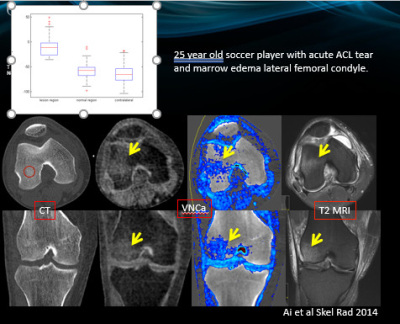Sunrise Session
Complementary & Hybrid Musculoskeletal Imaging
ISMRM & SMRT Annual Meeting • 15-20 May 2021

| Concurrent 7 | 13:00 - 14:00 | Moderators: Chiara Giraudo & Brian Hargreaves |
 |
Complementary Modalities: DECT
Katrina Glazebrook
Dual-energy CT provides material composition information. Removal of the calcium signal (virtual non-calcium VNCa) from cancellous bone allows visualization of the marrow space. Studies have shown high sensitivity and specificity compared to MR in cases of trauma in the scaphoid, hip, knee, and ankle (fig 1,2). VNCa imaging can demonstrate marrow infiltration in cases of metastases and myeloma (fig 3). DECT allows identification of MSU crystals in cases of suspected gout with high sensitivity and specificity compared to aspiration (fig 4,5). Monoenergetic DECT with iterative metal artifact reduction can improve image quality in cases with significant metal artifact (fig 6).
|
|
| Hybrid MRI Techniques
Feliks Kogan
Hybrid MRI methods promise to combine the high-resolution multi-contrast imaging benefits of MRI with new approaches aimed at early disease detection and clinical interventions. PET-MRI systems add metabolic and functional information from PET to potentially provide a complete imaging modality for studying musculoskeletal disease while high-intensity focused-ultrasound offers therapeutic interventions for bone tumors. This educational talk will discuss emerging applications of these technologies and their comparative advantages. Technical considerations and challenges as they specifically relate to musculoskeletal disease will also be discussed.
|
The International Society for Magnetic Resonance in Medicine is accredited by the Accreditation Council for Continuing Medical Education to provide continuing medical education for physicians.